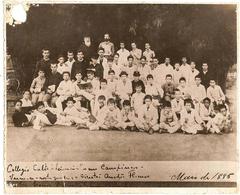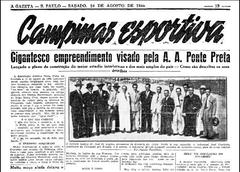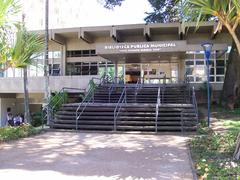
Igreja São Benedito Campinas: Visiting Hours, Tickets, and Historical Site Guide
Date: 03/07/2025
Introduction
Igreja São Benedito, situated in the center of Campinas, São Paulo, is a remarkable testament to Afro-Brazilian heritage, religious devotion, and cultural resilience. Built on the historic grounds of the Cemitério Bento, Campinas’ first cemetery established in 1754, the church is more than a place of worship: it is an enduring symbol of a community’s faith, struggle, and social empowerment. Established and safeguarded by the Irmandade de São Benedito—a brotherhood of enslaved and formerly enslaved Africans and their descendants—the church is celebrated for its rich traditions, architectural significance, and role in local history.
This comprehensive guide details the church’s origins, cultural importance, visitor information (including opening hours, accessibility, and ticketing), and practical travel tips, ensuring you have an enriching experience at one of Campinas’ most important historical landmarks (Centro de Memória UNICAMP; Recantos e Encantos; iabcampinas.org.br).
Table of Contents
- Introduction
- Historical Background
- Visitor Information
- Architectural Highlights
- Nearby Attractions
- Afrotourism & Educational Experiences
- Frequently Asked Questions (FAQ)
- Conclusion & Practical Tips
- References
Historical Background
Early Origins: The Cemitério Bento
The church’s story begins in 1754, with the founding of the Cemitério Bento—the city’s first cemetery and resting place primarily for enslaved individuals, including the first burial of an enslaved person belonging to Francisco Barreto Leme. Over time, this site became a sacred ground for the Afro-Brazilian community, fostering a collective sense of memory and identity (Centro de Memória UNICAMP).
Irmandade de São Benedito: Community, Faith, and Resistance
The Irmandade de São Benedito, a brotherhood founded by and for Africans and their descendants, played a central role in the church’s establishment. Formally recognized in 1899 but active since at least the 1830s, the Irmandade provided spiritual support, mutual aid, and a platform for cultural preservation. Leaders such as Mestre Tito (an ex-slave and healer) and Dona Ana de Campos Gonzaga were essential in mobilizing resources and completing the church’s construction (Recantos e Encantos; Caminhos Culturais).
Architectural Evolution
The original chapel, constructed in 1866 from a mausoleum, was later transformed into the church inaugurated in 1885. Architect Francisco de Paula Ramos de Azevedo designed the iconic façade, blending colonial, neo-Romanesque, and Gothic styles. The church’s architecture is distinguished by its overhanging eaves, “pombalina” window lintels, octagonal pillars, pointed arches, and a prominent tower added in the 1920s (iabcampinas.org.br).
Educational Initiatives
In 1897, the Irmandade established Colégio São Benedito, one of Brazil’s first schools for Black children, reinforcing the church’s commitment to social upliftment and access to education during a period when newly freed Black populations faced systemic barriers (Centro de Memória UNICAMP).
Monument to Mãe Preta: Memory and Recognition
In front of the church stands the Monument to Mãe Preta, inaugurated in 1984 after decades of advocacy. This monument honors Black women who played vital nurturing roles during and after slavery, symbolizing struggle, resilience, and recognition of Afro-Brazilian contributions to Campinas (A Cidade On).
Heritage Status
In 1998, Igreja São Benedito earned official heritage protection, cementing its status as a vital site for Afro-Brazilian memory, faith, and cultural preservation (Wikipedia).
Visitor Information
Location & Directions
- Address: Rua dos Iguás, 26, Vila Costa e Silva, Campinas, SP
- Easily accessible by public transport, ride-hailing apps, or car; parking is available on surrounding streets (Paróquia São Benedito – Vila Costa e Silva).
Visiting Hours & Tickets
- Opening Hours:
- Monday to Friday: 8:00 AM – 6:00 PM
- Saturday: 8:00 AM – 12:00 PM
- Sunday: 7:00 AM – 12:00 PM
- Extended hours during religious festivals and special events.
- Admission: Free of charge; donations are welcome.
- Mass Schedule: Sundays at 7:30 AM and during festivals.
Accessibility
- Wheelchair accessible entrance and restrooms.
- For additional assistance, visitors are encouraged to contact the parish office in advance.
Special Events & Festivities
- Festa Junina: June weekends feature traditional food, music, dance, bonfires, and Afro-Brazilian cultural presentations.
- Dia da Consciência Negra: November 20th celebrations include religious ceremonies, jongo dances, and community gatherings.
- Other Events: São Benedito’s feast (late January/February) and local afrotourism activities (Campinas.com.br).
Guided Tours
- Guided tours are available, especially during festivals and through afrotourism routes like Rotas Afro. Advance reservations are recommended.
Photography & Media
- Photography is allowed for personal use; avoid flash and be discreet during services.
- For professional photography, request permission from the parish office.
Dress Code & Etiquette
- Modest dress is required (shoulders/knees covered).
- Remove hats inside the sanctuary.
- Maintain silence and turn phones to silent mode during services.
Safety Tips
- Campinas is generally safe; standard precautions apply.
- Use ride-hailing services at night and secure valuables (WildTrips.net; HikersBay).
Architectural Highlights
- Construction: Brick masonry, stone foundations; central nave with side corridors.
- Façade: Colonial beiral, “pombalina” lintels, decorative appliqué, and a blend of Romanesque and colonial influences.
- Gothic & Neo-Romanesque Features: Octagonal pillars, pointed arches (veranda), and 1920s tower.
- Interior: Main altar painted to resemble marble, vaulted ceiling over altar, blue and white color scheme.
- Unique Elements: Monument to Mãe Preta, integration of colonial, Gothic, and neo-Romanesque styles.
Nearby Attractions
- Cemitério Bento: The original Afro-Brazilian cemetery.
- Monument to Mãe Preta: In front of the church.
- Catedral Metropolitana de Campinas
- Museu da Cidade
- Parque Portugal (Lagoa do Taquaral)
Afrotourism & Educational Experiences
Igreja São Benedito is a highlight of afrotourism in Campinas. The Rotas Afro project offers guided walks highlighting Afro-Brazilian history, heritage, and cultural sites, enhancing understanding of the community’s impact on local culture (A Cidade On).
Frequently Asked Questions (FAQ)
Q: What are the visiting hours?
A: Monday–Friday: 8:00 AM–6:00 PM; Saturday: 8:00 AM–12:00 PM; Sunday: 7:00 AM–12:00 PM.
Q: Is there an entrance fee?
A: No, entry is free.
Q: Are guided tours available?
A: Yes, especially during festivals and by reservation.
Q: Is the church accessible for visitors with disabilities?
A: Yes, ramps and accessible restrooms are available.
Q: Can I take photographs?
A: Yes, discreetly and without flash during services.
Q: How do I attend special events?
A: Check the parish website or local event calendars for schedules.
Conclusion & Practical Tips
Igreja São Benedito stands as a living symbol of Campinas’ Afro-Brazilian spirit, fostering faith, community, and cultural memory. With free admission, accessible facilities, and a rich calendar of festivals, the church welcomes everyone to experience its history and vibrant traditions. For an enhanced visit, plan around major festivities, explore afrotourism options, and consult the parish or the Audiala app for the latest updates.
Don’t miss the chance to experience this beacon of heritage—combine your visit with other cultural sites in Campinas for a rewarding and insightful journey.
References
- Centro de Memória UNICAMP
- Recantos e Encantos
- Caminhos Culturais
- Campinas.com.br
- iabcampinas.org.br
- Paróquia São Benedito – Vila Costa e Silva
- A Cidade On
- WildTrips.net
- HikersBay
- Wikipedia






